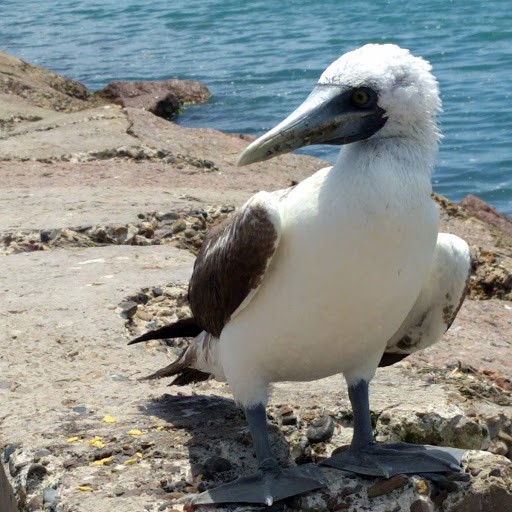by M. Kathy Raines

A massive bill, like an oddly-fitting mask, protruded from its face. The large white bird with slender brownish-black wings and a pointed tail—clearly not a pelican—stood on its platform feet, scarcely moving, right next to me on the jetties one July afternoon last summer. And it permitted closeup after closeup.
Soon I realized, with glee, I had seen a masked booby, a pelagic bird, or one that spends most of its time miles away from shore. I had just learned about these from Javier Gonzalez, onsite Naturalist Educator at the South Padre Island Birding and Nature Center from his talk on summer birds.
Though sightings are uncommon, this booby and the brown booby—two of six species of them—do appear, often in July, on South Padre Island’s beaches, jetties or piers. And later that year, Island residents and tourists were treated to more encounters with masked boobies.
With an unusually scant fear of people, these boobies sit nonchalantly as thrilled visitors snap photos or feed them scraps, and some urgently call the Coastal Studies Lab or Birding and Nature Center to report what they surmise, due to its apparent tameness, is an injured bird.
This booby is “masked” in that a black “mask” surrounds its eyes and bill. The name “booby”—a modification of the Spanish “bobo”, meaning “fool”—likely arose either from the ease with which Spanish sailors were able to capture and eat them as they rested atop their ships, or due to the birds’ seemingly awkward courtship behaviors.
During one of these routines, “sky pointing”, the male, head thrown back and beak skyward, whistles. Also, he, and sometimes his intended mate, engage in “parading”, during which one or both boobies walks about, tail uplifted, swaying from side-to-side, displaying its feet. The male may also offer the female a gift, perhaps rocks or feathers.
Boobies, generally monogamous, nest in colonies on island ledges, plateaus, shrubs or small trees. Both parents place their blue eggs beneath the webs of their feet to keep them warm.
A masked booby lays two eggs, evidently to ensure that at least one chick survives, since an egg hatches only 60% of the time. Since parents usually only nurture one chick, the older chick, in an act of “siblicide”, may push the younger one from the nest, after which it dies from exposure or predation.
An infant rests atop its parents’ feet for a few days, under their constant attention. It fledges in from 12-25 weeks, but its parents continue nurturing it for another nine months or so.
Boobies, wings held backwards to decrease wind resistance, plunge vertically into the ocean from heights of over 90 feet to catch prey, some of their favorite being tuna, squid, and flying fish—which they may catch mid-leap. With superb binocular vision, boobies may capture prey at any point—upon impact, while swimming, or as prey surfaces.
Flying with its fellows just above the water, a booby may dive for one fish, but boobies usually plunge into shoals of them, driven upwards by larger fish, these masses creating a sheen visible to overflying seabirds. In the ensuing feeding frenzy, a larger magnificent frigatebird may snatch a booby’s quarry, forcing it to disgorge it.
To maintain aerodynamics, a booby stores its prey in a crop, or pouch, within its throat, thus preventing large prey from weighing it down.
Masked boobies can live for as long as twenty years; however, as with other seabirds, they can die from eating plastics found in the ocean. And, unfortunately, plastic has shown up in boobies’ nests. Also, these birds may become entangled in fishing gear or hooked on lines. The booby’s greatest danger, though, according to birding scholar David Attenborough, may arise from the overfishing of its prey.

